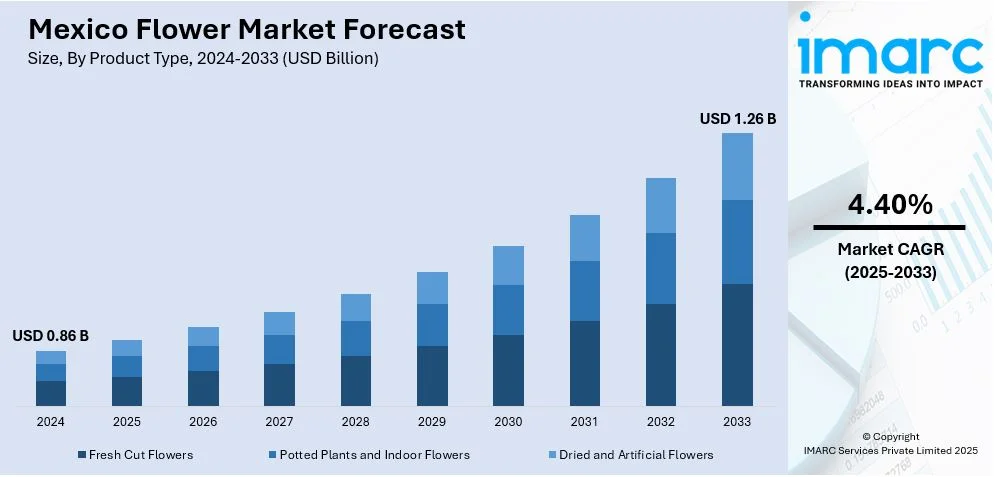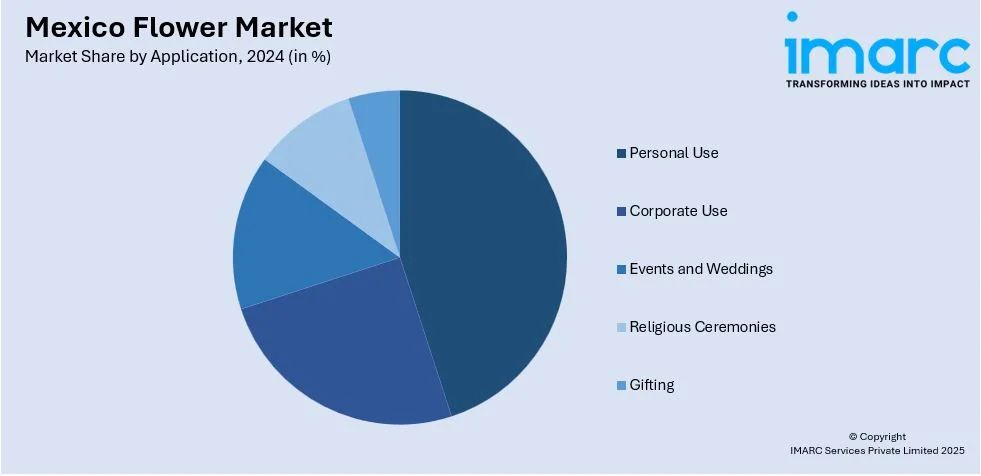
Mexico Flower Market Size, Share, Trends and Forecast by Product Type, Application, Distribution Channel, and Region, 2025-2033
Mexico Flower Market Overview:
The Mexico flower market size reached USD 0.86 Billion in 2024. Looking forward, IMARC Group expects the market to reach USD 1.26 Billion by 2033, exhibiting a growth rate (CAGR) of 4.40% during 2025-2033. The Mexico flower market is being driven by favorable climatic conditions for year-round cultivation, strong export potential to nearby countries like the U.S., escalating domestic demand influenced by cultural traditions and urban lifestyle shifts, increased popularity of floral events and festivals, and the rising use of digital platforms for flower sales and delivery.
|
Report Attribute
|
Key Statistics
|
|---|---|
|
Base Year
|
2024
|
|
Forecast Years
|
2025-2033
|
|
Historical Years
|
2019-2024
|
| Market Size in 2024 | USD 0.86 Billion |
| Market Forecast in 2033 | USD 1.26 Billion |
| Market Growth Rate 2025-2033 | 4.40% |
Mexico Flower Market Trends:
Favorable Climate and Geographic Advantages
Among the strongest drivers of the Mexico flower market is the favorable climate and geographic location of the country, providing optimal conditions for growing a broad range of flowers. The topography of Mexico, which spans from highlands to lowland tropical regions, provides a suitable environment for the cultivation of a large number of flower varieties throughout the year. Provinces such as Puebla, Mexico State, and Morelos have temperate climates and rich volcanic soil that favors the cultivation of high-value flowers such as roses, chrysanthemums, and lilies. The nation's mild temperatures and stable daily sunlight patterns during all seasons reduce the use of costly artificial cultivating conditions such as greenhouses, minimizing producers' overhead expenses. The low levels of frost and drought in major flower-producing areas also protect crop yields, making supply more dependable. Access to major export markets, specifically the United States and Canada, is also advantageous logistically. Fresh flowers are highly perishable, so transportation times need to be as short as possible in order to ensure product quality. Mexico's geographic location allows for same-day or one-day delivery, particularly around holiday periods such as Valentine's Day and Mother's Day.

Rising Domestic Demand Fueled by Cultural and Social Shifts
Another major driver is the upsurge in domestic demand, fueled by changing cultural attitudes, shifting lifestyles, and expanding disposable income levels among the middle class. Though flowers have historically played a cultural role in such traditional celebrations as Día de los Muertos and religious ceremonies, today there is an increasing trend of flower giving on birthdays, graduations, anniversaries, and business occasions — traditions previously not so prevalent in Mexican culture. Urbanization and modernization have brought with them new consumption habits, especially in urban centers such as Mexico City, Guadalajara, and Monterrey, where online flower delivery services and florists are widely on the rise. Younger generations are now more likely to buy flowers as decorative pieces or mood boosters, driven by social media trends on platforms such as Instagram and TikTok. This has widened the market from ceremonial or seasonal use to regular consumption. Additionally, advancements in e-commerce and mobile apps have increased flower accessibility to wider populations. Digital platforms have facilitated the purchase process, promoting impulse buying and gift-giving that transcends geography. Subscription flower services are becoming extensively popular with urban consumers as they look for convenience and attractive home decor.
Mexico Flower Market Segmentation:
IMARC Group provides an analysis of the key trends in each segment of the market, along with forecasts at the region/country level for 2025-2033. Our report has categorized the market based on product type, application, and distribution channel.
Product Type Insights:
- Fresh Cut Flowers
- Potted Plants and Indoor Flowers
- Dried and Artificial Flowers
The report has provided a detailed breakup and analysis of the market based on the product type. This includes fresh cut flowers, potted plants and indoor flowers, and dried and artificial flowers.
Application Insights:

- Personal Use
- Corporate Use
- Events and Weddings
- Religious Ceremonies
- Gifting
A detailed breakup and analysis of the market based on the application have also been provided in the report. This includes personal use, corporate use, events and weddings, religious ceremonies, and gifting.
Distribution Channel Insights:
- Online Retail
- Offline Retail
The report has provided a detailed breakup and analysis of the market based on the distribution channel. This includes online retail and offline retail.
Regional Insights:
- Northern Mexico
- Central Mexico
- Southern Mexico
- Others
The report has also provided a comprehensive analysis of all the major regional markets, which include Northern Mexico, Central Mexico, Southern Mexico, and others.
Competitive Landscape:
The market research report has also provided a comprehensive analysis of the competitive landscape. Competitive analysis such as market structure, key player positioning, top winning strategies, competitive dashboard, and company evaluation quadrant has been covered in the report. Also, detailed profiles of all major companies have been provided.
Mexico Flower Market News:
- April 2025: The 2025 Polanco Flower and Garden Festival in Mexico City, held from April 3 to April 6, transformed Parque América and Masaryk Avenue into vibrant floral showcases. This year's theme, "The Future", inspired designers, florists, and artists to create imaginative installations featuring floral arches and futuristic garden concepts. The event celebrated spring with public access, inviting visitors to enjoy and photograph the colorful displays.
- April 2025: Imaginary Worlds launched its luxurious Ramo Buchón collection in Mexico City. These opulent arrangements feature preserved roses that maintain their beauty for 3–5 years, offering a sustainable alternative to traditional bouquets. Ramo Buchón bouquets are ideal for significant occasions like quinceañeras, weddings, and anniversaries, blending tradition with modern luxury.
Mexico Flower Market Report Coverage:
| Report Features | Details |
|---|---|
| Base Year of the Analysis | 2024 |
| Historical Period | 2019-2024 |
| Forecast Period | 2025-2033 |
| Units | Billion USD |
| Scope of the Report |
Exploration of Historical Trends and Market Outlook, Industry Catalysts and Challenges, Segment-Wise Historical and Future Market Assessment:
|
| Product Types Covered | Fresh Cut Flowers, Potted Plants and Indoor Flowers, Dried and Artificial Flowers |
| Applications Covered | Personal Use, Corporate Use, Events and Weddings, Religious Ceremonies, Gifting |
| Distribution Channels Covered | Online Retail, Offline Retail |
| Regions Covered | Northern Mexico, Central Mexico, Southern Mexico, Others |
| Customization Scope | 10% Free Customization |
| Post-Sale Analyst Support | 10-12 Weeks |
| Delivery Format | PDF and Excel through Email (We can also provide the editable version of the report in PPT/Word format on special request) |
Key Questions Answered in This Report:
- How has the Mexico flower market performed so far and how will it perform in the coming years?
- What is the breakup of the Mexico flower market on the basis of product type?
- What is the breakup of the Mexico flower market on the basis of application?
- What is the breakup of the Mexico flower market on the basis of distribution channel?
- What is the breakup of the Mexico flower market on the basis of region?
- What are the various stages in the value chain of the Mexico flower market?
- What are the key driving factors and challenges in the Mexico flower market?
- What is the structure of the Mexico flower market and who are the key players?
- What is the degree of competition in the Mexico flower market?
Key Benefits for Stakeholders:
- IMARC’s industry report offers a comprehensive quantitative analysis of various market segments, historical and current market trends, market forecasts, and dynamics of the Mexico flower market from 2019-2033.
- The research report provides the latest information on the market drivers, challenges, and opportunities in the Mexico flower market.
- Porter's five forces analysis assist stakeholders in assessing the impact of new entrants, competitive rivalry, supplier power, buyer power, and the threat of substitution. It helps stakeholders to analyze the level of competition within the Mexico flower industry and its attractiveness.
- Competitive landscape allows stakeholders to understand their competitive environment and provides an insight into the current positions of key players in the market.
Need more help?
- Speak to our experienced analysts for insights on the current market scenarios.
- Include additional segments and countries to customize the report as per your requirement.
- Gain an unparalleled competitive advantage in your domain by understanding how to utilize the report and positively impacting your operations and revenue.
- For further assistance, please connect with our analysts.
 Request Customization
Request Customization
 Speak to an Analyst
Speak to an Analyst
 Request Brochure
Request Brochure
 Inquire Before Buying
Inquire Before Buying




.webp)




.webp)












